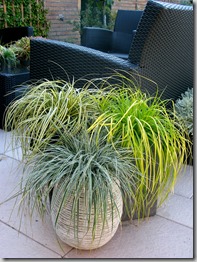
While I won’t go so far as to recommend you take gardening advice from your cat, ornamental grasses comprise such a broadly useful array of plants for the landscape that it’s almost impossible to avoid falling in love with at least a few of them. Some are wispy and rustle in the wind, some are bold and sculptural, while others have a flowing appearance which softens the look of shrubs.
New ornamental grasses are coming out every day, with exciting foliage colors, interesting forms, and improved vigor. I recently wrote to some of the growers involved in developing ornamental grasses to ask them what is new and fabulous in the world of grasses. And to make it a little simpler, I’ve compared and contrasted these newer varieties with some familiar favorites so you can get an idea of when to choose which.
Old fave: variegated Japanese forest grass, Hakonechloa ‘Aureola’: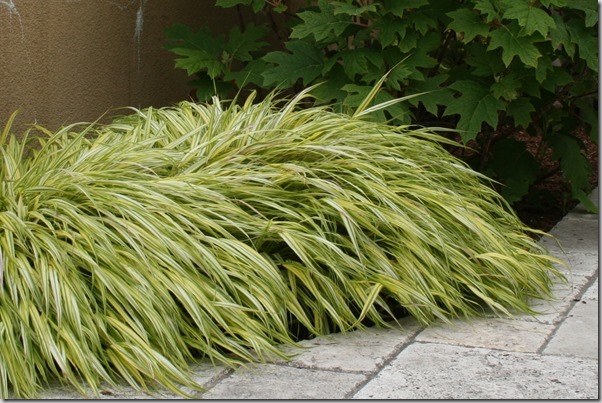
New fave: All Gold Japanese forest grass, Hakonechloa ‘All Gold’: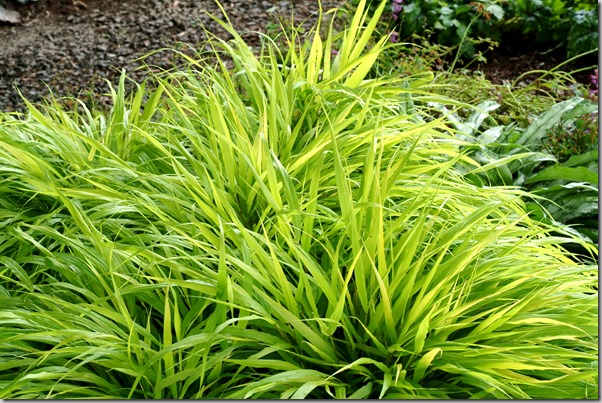
We are all familiar with the uber-popular variegated Japanese forest grass, a slowly spreading grass with subtle creamy-gold stripes and a flowing habit which is perfect for flowing over a garden wall, softening the edges of hardscaping, or bringing contrast to a stiffly upright shrub.
All Gold Japanese forest grass is a newer introduction (recommended by Terra Nova Nurseries)which ditches the stripes in favor of brilliantly bold foliage. In my experience, it is ever so slightly less vigorous than the regular variegated Japanese forest grass, which can be nice in a smaller garden.
Variegated Japanese forest grass is perfect if you have a large hillside you want to cover, or don’t want to see distinct spaces in between your plants. However, in smaller gardens it can overwhelm the space. The more sedately growing All Gold can be a better choice for urban gardens, or next to a small patio.
Here in the coastal Pacific Northwest, regular variegated Japanese forest grass can almost tolerate full sun, though it definitely looks best with a little midday screening. But I have found it looks a little scraggly and is slower to take off in gardens with deeper shade. All Gold by contrast is more prone to sunburn, but has a dense habit which looks more full when it’s establishing then does the rangier variegated variety.
I also really love the added brightness of all gold in shadier spots – it’s almost fluorescent. That vivid coloration is perfect against the deep greens of conifers, rhododendrons, and other evergreens. While both Japanese forest grass varieties go dormant in winter, it takes almost no time to use a pair of handheld hedging shears and cut them down to a couple inches from the ground.
Old fave: Evergold sedge, Carex ‘Evergold’: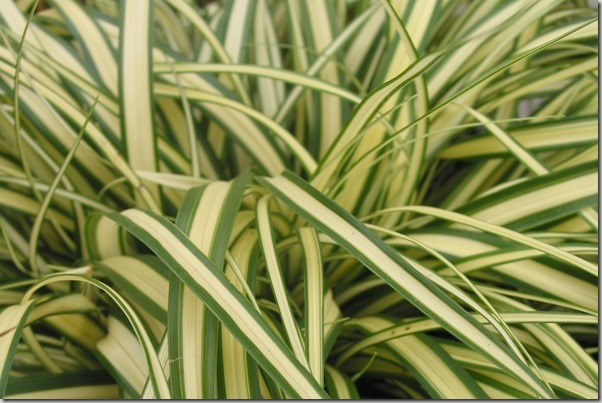
New fave: Spark Plug sedge, Carex ‘Spark Plug’: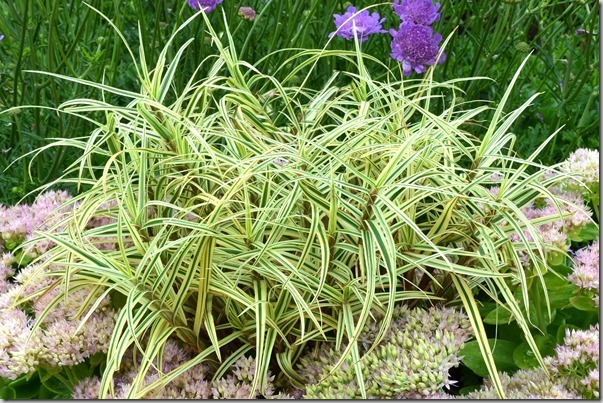
Evergold sedge, introduced by Pat Fitzgerald and recommended by both Skagit Gardens and Hoffman Nursery, is another that has taken off in popularity in recent years. It has a compact habit and makes cute little mounds in the landscape, and I love the way it has a distinct form, yet also looks great massed.
Because it’s evergreen, it rarely needs any maintenance at all beyond occasionally removing a few individual brown strands. I love using Evergold sedge in the foreground of shrub or perennial plantings, where its tidy habit makes the rest of the garden look well-maintained by association.
Spark Plug sedge (from Terra Nova Nurseries), by contrast, should be used in a totally different way. While these two sedges are both a similar height and color, Spark Plug sedge has such a wild, twirling habit that it almost calls out to be a focal point in and of itself. This is pretty rare for a plant that doesn’t top 18 inches.
Spark Plug sedge would be an awesome choice in all-foliage gardens where the emphasis is on form and foliage color. Imagine this wild firecracker of a plant next to the corkscrew branches of Harry Lauder’s walking stick, or near the ropy golden twists of Cryptomeria ‘Sekkan Sugi’. Of course, you can see by the photo above that Spark Plug is equally at home bringing that designer edge to a flower garden, where its curling spikes contrast against the softness of traditional border perennials.
Old fave: purple fountain grass, Pennisetum setaceum ‘Rubrum’: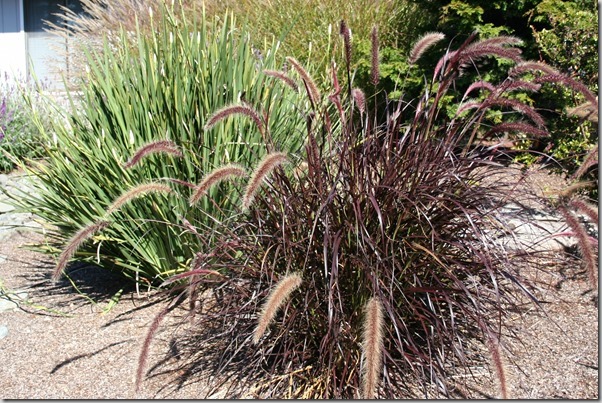
New fave: Fireworks fountain grass, Pennisetum ‘Fireworks’:
In my damp climate, purple fountain grass is one of those where we cross our fingers and hope every winter that it will come back despite our soggy, sodden soils. Yet we keep planting it, because it is one of the most spectacular ornamental grasses around.
That purple-bronze foliage emerges by May and in midsummer puts up brilliantly fluffy purple flower poofs which age to a soft beige-y white. The way those showy floofs move gently in the late afternoon breeze makes us go a little crazy, and puts us into a state of zonal denial that makes us willing to purchase these plants year after year, if we aren’t lucky enough for them to live over (you lucky ducks in SoCal get to enjoy them as evergreens, an unfairness of the universe that I shall never get over).
Anyway, if you lose your head over the regular purple fountain grass, you’ll definitely want to check out Fireworks fountain grass, a hot new variegated version with stripes of white, green, burgundy and hot pink (recommended by ItSaul Plants).
Though one nursery’s website touts it as a great plant for Asian or Zen gardens, I think those people are absolutely insane. This grass is bright and over-the-top, a flirtatious floozy of the ornamental grass world. Putting it in a restrained Japanese-style garden would be like having Carmen Miranda in a room full of stuffy suits. Give this grass the lush, tropical, heavily flowered setting it deserves, and watch it shine as the star of the garden.
Have you seen any cool new grasses kicking around the nursery lately? Which ones are on your must-buy list? Let me know in the comments below.
Photo credits:
Carex ‘Evergold’, ‘Everillo’, and ‘Everest’: Hoffman Nursery
Hakonechloa ‘All Gold’: Terra Nova
Carex ‘Spark Plug’: Terra Nova
Pennisetum ‘Fireworks’: ItSaul Plants
25 responses to “Grassy Favorites, New and Old”
Pennisetum ‘Vertigo’ if you’re looking for a big, dark grass.
I’ve been looking at ‘Fireworks’ the last couple of years, but I think it’s just too pink for me. Maybe I need to grow it to really judge, instead of just seeing it in small pots on the shelf.
Too pink! Throw a little glitter around the garden and it’ll fit right in.
I’ll check out Vertigo – thanks for the tip, Alan! 🙂
Gen, these are gorgeous and they seem like trouble-free plants. I’m planning to integrate my new coop and run into the landscape, and I’ve been thinking that strategically placed grasses might give it some easy mounds of color.
Can you recommend a grass or two that’s non-invasive and that can handle a New England winter?
🙂 Lauren
Oh for sure!! Panicum (any), Hakonechloa (partial shade), and Pennisetum (the green ones), to start. I found this Pinterest board for inspiration: http://pinterest.com/ingospsiena/ornamental-grasses-for-cold-climate/
But the best way to go is to get inspired online, then bring the names into your local nursery and ask for their advice. They’ll know your local soil and climate and can advise you as to good design pairings based on what you can grow. But most grasses are pretty hardy! I may have more trouble than you because most grasses prefer cold to wet.
Thank you, Gen! I will get panicum, if only for its name! This is going to be a really fun project. Should be all assembled by June. .. I’ll take pix!
Lauren
Oh, sweet!!! When you take your “before” pics, make sure you take them from an identifiable, repeatable place on your home or garden (don’t just stand somewhere random in the garden to take the shots) – I like to stand at corners of the house, doors, etc and take three angles from each spot, so your before and after shots look like the exact same location! It’s quirky to care about such things, but before-and-afters are so satisfying.
Love love love the Carex ‘Spark Plug’! Fabulous. Thanks for the design tips on these grasses, I’ll be looking at what to add to my new garden this year.
Isn’t that a cutie?? I dig Sparkler sedge, and Spark Plug looks a little more upright – Sparkler always seems to flop a bit.
I have several of those grasses. I love them. The ‘Fireworks’ is new to me. I have sandy soil. It might work.
Fireworks Fountain Grass speaks to my soul. But I heard an internet rumor that it’s prone to reverting back to its unvarigated form when it returns in the Spring. Does that make it a ‘win’ that it’s not likely to do that here? Yay? Probably not. But I must grow it this year.
Oh I absolutely love ‘Fireworks.’ I hope I can find it here. It’s not even close to hardy here, but neither is ‘Rubrum’ and it grows beautifully as an annual. And of course I adore ‘All Gold’
That’s definitely how I use any kind of colored Pennisetum – as an annual. If I get lucky and they return – awesome! Otherwise I just invest in the biggest specimen I can find and enjoy the show while it lasts.
Thank you for the super informative article! These are some of my new found favorites as well. (:
Super good site, very informative Thanks
One of my favorites is Zebra Grass. Fairly easy to maintain. Doesn’t need much water and will last through the winter. Very pretty.
I’ve been away for a while (getting my mother situated in a care facility). What a pleasure to see the pictures of your cats in the grasses. Mine would be right in there as well.
Hakonechloa is bullet-proof in my garden and I’ve always been a diehard ‘Aureola’ fan. I planted some ‘All Gold’ last year and so far I ‘m loving it, too. I also use Korean feather reed grass since it flowers well in fairly dense shade, unlike most other grasses.
Hi Gen! I love this post. I like the combination of Spark Plug and Fireworks. I already have Spark Plug on my garden and I’m planning to plant Fireworks too! 😀
Gotta love grasses! I’ve always liked the taller varieties to hide eyesores more than as specimen plantings I see more frequently. On my “must try” list (purchased this afternoon) is dwarf blue fescue (Elijah Blue). Something I’ve admired and just never tried. First planting will accent some recent divisions of Ruby Stella daylilies and second will be filler for a small rose bed partially accented with stone. Should have a new blog and pics coming by the end of the month, off to plant now.
Amazing photos! I’m a big fan of ornamental grasses and especially the Gold Japanese forest grass. Given the right healthy soil is the foundation to my success.
Genevieve, thanks so much for providing information on where and how these grasses fit in the garden. I see so many that look cool, but how they will fit in and work where I am is a mystery. And love the idea of a “corkscrew” garden!
Genevieve, thanks so much for providing information on where and how these grasses fit in the garden. I see so many that look cool, but how they will fit in and work with where I am and what I’ve got is a mystery. And love the idea of a “corkscrew” garden!
Have you ever tried growing any of these grasses as part of a vertical living wall? The color and texture variety certainly would make them interesting living wall components. The usual focus is on plants found in more tropical regions, suitable for indoor walls or outdoor walls in warmer climes.
Living walls certainly exist in colder areas, but it isn’t often you find detailed descriptions of all the plants on them.
It is a brilliant idea to have one of these pretty ‘grasses’ in our garden, I especially loved the dense and green Japanese forest grass. I would love to know more about it, how you grow it, do we need to buy seeds or some thing else?
Pennisetum “Fireworks” is a new one on me – I’ll have to see if I can order some seed as we don’t have any grass specialists locally here in France.
One of my favourites is Imperata cylindrica “Red Baron”, aka Japanese Blood Grass.
Phil